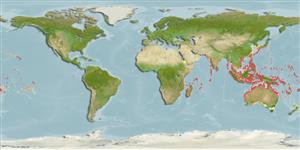Common names from other countries
Classification / Names / Names
Nomi Comuni | Sinonimi | Catalog of Fishes (gen., sp.) | ITIS | CoL | WoRMS
Environment: milieu / climate zone / depth range / distribution range
Ecologia
; distribuzione batimetrica 0 - 25 m (Ref. 349). Tropical; 36°N - 44°S, 32°E - 138°W
Indo-Pacific.
Length at first maturity / Size / Peso / Age
Maturity: Lm ? range ? - ? cm Max length : 32.0 cm SHL maschio/sesso non determinato; (Ref. 101509); common length : 17.0 cm SHL maschio/sesso non determinato; (Ref. 101509)
Shell length varies between 8.5 cm and 32 cm (Ref. 101509). Found in coarse sand with coral rubble and algae. Littoral to sublittoral, in tide pools and low tide level (Ref. 349). Inhabits seagrass beds (Ref. 98586).
Life cycle and mating behavior
Maturità | Riproduzione | Deposizione | Uova | Fecundity | Larve
Members of the order Neotaenioglossa are mostly gonochoric and broadcast spawners. Life cycle: Embryos develop into planktonic trocophore larvae and later into juvenile veligers before becoming fully grown adults.
Smith, B.D. 2003. (Ref. 3116)
IUCN Red List Status (Ref. 130435)
CITES status (Ref. 108899)
Not Evaluated
Not Evaluated
Threat to humans
Harmless
Human uses
Pesca: commerciale
| FishSource | Sea Around Us
Strumenti
Informazioni ulteriori
Age/SizeAccrescimentoLength-weightLength-lengthMorfologiaLarveAbbondanza
Fonti Internet
Estimates based on models
Preferred temperature
(Ref.
115969): 23.3 - 29.3, mean 28.3 (based on 3868 cells).
